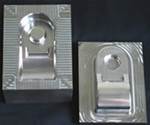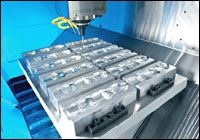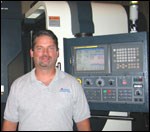Taking Control of Finer Surface Finishes at Higher Speeds
An increased interest in five-axis machining—coupled with advances in controls and cutting tools—add up to finer surface finishes at higher speeds.
The industry's ever-increasing demand for shorter leadtimes has resulted in a number of improvements in machining equipment—new control capabilities, better cutting tools, higher speed spindles, advances in high-speed machining and increased five-axis machining capabilities. Some major machine manufacturers discuss industry trends for the moldmaker who is on the lookout for ways to reduce machining cycle times while maintaining greater surfaces and higher accuracies.
1. What major advancements to you foresee in machining this year? And how will these advancements affect the moldmaker, mold designer and the moldmaking process in general?
Steve Ortner, President, Absolute Machine Tools, Inc. (Lorain, OH): Moldmakers will see a number of incremental advances that, when combined, will lead to another year of significant process improvements for the moldmak-ing industry. New control capabilities, cutting tools and CAM software now let moldmakers take advantage of advanced machine tools—and by this, I mean machines with the strength, rigidity and reliability to handle complex contours and fine surface finishes at high speeds. Expect advanced CNCs providing major gains in servo performance to raise feedrates and to shorten cycle times. Machine designs will continue to keep pace with these new capabilities. In addition, spindles continue to be refined, with rpm pushed to new limits. Improved cutting tools will deliver higher feedrates and longer cutting life. Finally, upgraded CAM software will take advantage of the latest machine and control technology. Combining these technologies lets moldmakers and mold designers push the limits of their design and machining capabilities to create more complex molds with finer finishes at significantly reduced cycle times.
Wes Daughaday, Applications Engineer, Kitamura Machinery of USA, Inc. (Wheeling, IL): We see major advancements in the control field. The next generation of CNCs will take a quantum leap as far as multi-axis machining is concerned. This will provide the moldmaker more speed, finer finish capability and accuracy than ever before. There also is an increased interest in five-axis machining, which is ideal for machining complex parts requiring high accuracies and precision mold jobs.
Mark Rentschler, Marketing Manager, Makino (Mason, OH): The major force in the die/mold industry continues to be a revolution in the processes used to produce dies and molds. We continue to move from a very labor-intensive manu-facturing system to one which takes ad-vantage of a process-driven approach. The companies that have adapted to this approach and invested in the high tech-nology equipment are having good success in competing with overseas competition. This need for automated and unattended processes has forced a shift in the capabilities of the machinery that the die/mold customer needs. Today the industry needs a much more accurate and thermally stable machine to facilitate the ability to machine to zero or negative stock and allow assembly of molds without fitting or benching to achieve good parts from the first sample.
High-speed spindles provide the ability to run smaller tools, finer pick-feeds/"step-over", sharper corners, etc.—resulting in reduced machining cycle times, much higher surface finishes, higher accuracies, less (or elimination of) hand finishing/fitting, repeatability of process (i.e., ability to repeatedly produce "replacement" parts for production molds in less time/effort while assuring first time productivity by reducing/eliminating hand fitting/hand working).
Advancements in high-speed servo control and data processing to support HSM of complex, 3-D shapes/profiles typical of die/mold applications also aids in the process by:
- providing significant reductions in cycle time for cutting complex three 3-D shapes/profiles;
- providing outstanding control over 3-D integrity (even at high feeds) resulting in extremely accurate 3-D profiles, elimination of "overshoot", "miss-match" and "blend issues", etc.; and,
- extremely precise machine tools/controls/high-speed spindles/HSM—supported by advanced CAD/CAM systems can create highly accurate, high quality surface finishes/blends/matches, etc. in a "first time" production tool and eliminating the need for prototyping steps, time-consuming (and labor-intensive) hand fitting/finishing/matching steps, etc.
The enhancement in the control area helps the operator to be more productive, more quickly, and provides more information to the operator in a more usable format and manner. This ensures the highest utilization (and productivity) of both the operator and machine tool asset. In addition, the Ethernet linked, file tree format and open architecture facilitates the rapid exchange of information from support systems (i.e., CAD/CAM system) to the machine tool—getting (and keeping) the machine productive.
All of these elements help to reduce the overall timeframe and cost for producing dies and molds by reducing the machining cycle time (high-speed spindles, HSM, servo/control capabilities, etc.), reducing the time to get ready to machine (i.e., CAD/CAM systems, user-friendly control/communication capability/data transfer/ease of setup, keeping the machine busier, etc.), reducing "post-machining" efforts (i.e., hand working, hand fitting, hand finishing, etc. through HSM, CAD/CAM, advances in machine accuracies, control capability, cutting speeds/feeds/productivity, etc.), and increased productivity, throughput, accuracy and capability.
Mal Sudhakar, Vice President, Mikron (Lincolnshire, IL): General trends that are driving changes in machining center/cell technology include high-speed machining (HSM), multiprocessing, automation and smart machining.
HSM, which can dramatically reduce machining cycle times, manufacturing leadtimes and costs, is increasingly being used for a growing number of applications. HSM is characterized by cutting speeds that are five to 10 times higher than conventional machining, which requires higher spindle speeds, feedrates and acceleration on machining centers. A few years ago, machining centers had top spindle speeds of 8,000 rpm, feedrates of 400 ipm and acceleration of 0.1 or 0.2 g. Today, many high-performance machining centers are available in the market with spindle speeds up to 20,000 rpm, feedrates of 1,600 ipm and acceleration of 0.5 g. A further step above this are HSM centers with spindle speeds up to 60,000 rpm, feedrates of 3,000 ipm and acceleration of 1 g and higher.
With demand from the marketplace for shorter manufacturing leadtimes, shops are looking for ways to combine more operations on one machine. While turn/mill centers are offering more capabilities and becoming more prevalent, the use of five-axis machining centers also is increasing. Five-axis machining centers provide the capability of multi-sided machining in one setup. Today, a variety of five-axis machining centers are available in the market at more affordable prices, and many shops are getting into this technology.
In today's global manufacturing environment, shops are looking to slash labor costs and achieve the maximum possible output out of a machine to generate the highest revenue per employee. This is being achieved by automation, by utilizing as many hours as possible of the total 8,760 hours available in a year for actual machining operations. Machining centers today are therefore being designed for automation, offering integrated multi-station pallet changers or the capability of being easily interfaced with a robot.
With the trends toward HSM, multiprocessing and automation, follows the development of smart machining. Smart ma-chining is a new technology developed to bring intelligence to the machining process in order to improve reliability, optimize machining performance and allow depend-able unmanned operation. Examples of smart machining technology are real-time monitoring of spindle vibration in a HSM process, intelligent thermal control to automatically compensate for thermal drifts in a machine, and communication of the operating status of a machine from the CNC to a PC or cell phone.
Dave Austin, Marketing Manager, Mori Seiki USA, Inc. (Irving, TX): We are focusing on a few areas. First, we are reducing the vibration at the tool tip—using a technology in which the net driving force acts through the center of the axis—because it drives down the overall cost of machining. There are several benefits of reducing vibration:
- The parts are more precise because the tool tip is controlled more precisely.
- Parts can be machined faster because you can use higher cutting feedrates.
- The surface finish is improved, decreasing the amount of secondary operations.
Second, we are finding methods to reduce setup time and idle time of the machine tools. We continue to develop automation options for our machine tools to decrease the setup time to get the first part into production, and for loading and unloading the parts to decrease the net cycle time.
Last, we are continually improving the non-cutting times to improve the part cycle time. Faster rapid traverse rates, more powerful spindles and faster tool changers are essential in this area.
As an example of the advancements above, improved tool life is an aspect of reduced vibration that dramatically impacts the cost per part. Since tool replacement requires the machine to sit idle, extending tool life can substantially improve productivity as well as reduce tooling costs. Tooling costs can easily equal the cost of the machine tool when considered over the lifetime of the machine.
2. What common challenges do moldmakers face with machining today and what are some recommended solutions?
Ortner, Absolute Machine Tools: The single most common question we are asked is "Why (or how) are our competitors pricing molds so cheaply?" That is usually followed by the statement that "They had to lose money at that price." My response is that it's unlikely that anyone is making molds at a loss. The real issue is moldmakers investing in high-speed machining centers, advanced tooling, and the right software are producing molds faster and at a reduced cost while maintaining a healthy profit margin. When moldmakers say they have to take work at $35 per hour just to get it, I suggest their process is no longer competitive. Their competition gets it done—often in one-third the time—at $100 per hour. The way to remain competitive is by investing in the latest machine technology, tooling, and software and using the latest machining methods to do jobs right the first time.
HSM continues to evolve, and we are introducing new machine tools that are faster, more agile and specifically engineered for the mold industry. In addition, we continue to do a lot of test cutting to obtain valuable knowledge of the entire moldmaking process. Much of this is proprietary work that we only share with our customers, but I can tell you that we've found ways to successfully hard mill complex shapes in 60 Rc material. We're roughing and finishing these jobs to demanding surface finishes, getting rid of sinker EDM operations and virtually eliminating handwork. We have customers machining molds to such high levels of accuracy that they're putting them on spotting presses for hours rather than weeks. And many shops also are reaping the benefits of unattended machining. They run jobs overnight to eliminate labor costs and to be more competitive on price.
Rentschler, Makino: There has been a significant shift in our industry over the past few years. Traditionally, the customer was more focused on the statistics of the machine tool and discussion of spindle capability, travels and topics of this sort. Recently our die/mold customers have become much savvier and are asking much more detailed questions about the application of the machines' technology and after sales support that comes with the machine. We have always been focused on the process of manufacturing and teaching our customers how to reduce costs and minimize leadtimes so this shift has been very enjoyable for us to see. It allows us to engage a larger portion of the die/mold industry and help more of that industry to prosper in North America. Ultimately, the more North American shops that survive in the global market the better off it will be for our business as well.
Our die/mold applications staff is very focused on the innovation and technology transfer of revolutionary processes to allow the companies we work with to be more competitive and more efficient. Recently we have worked on development of processes for productionizing the manufacture of inserts reducing cycle times by as much as 80 to 90 percent by using horizontal machining centers and revolutionary workholding techniques. We also have pushed the envelope in practical machining of 62-64 HRc materials and deep rib machining as deep as 30:1 tool length to diameter and beyond. We also have been able to develop techniques to machine lens molds that require no benching which has reduced the cost of manufacture as well as leadtime dramatically for these types of molds.
Sudhakar, Mikron: The HSM, multiprocessing, automation and smart machining challenges and trends are being addressed today by the wide range of high-speed and high-performance machining that is available in a variety of three- to five-axis configurations. HSM centers with spindle speeds up to 60,000 rpm and axis acceleration of over 1 g. are also available, and some machines are even designed for automation offering an integrated pallet changer for an easy interface for a robot.
One such solution that embodies all the above trends is a five-axis HSM center equipped with a 21.5 hp, 20,000-rpm spindle, a versatile rotary/tilt table for five-axis/five-sided machining, a laser tool measuring system, a part probe, an integrated table chuck for palletization, an integrated seven-position pallet changer and smart machining modules for vibration monitoring and intelligent thermal control.
Austin, Mori Seiki: Moldmakers want to know how they can reduce leadtimes for die and mold production? The answer lies in highly reducing—and in some cases—eliminating the finishing operations by producing extremely high quality surface finishes. To reduce the overall cost of die and mold machining, one needs to enable savings in tooling consumption, power consumption, downtime and especially in cycle time—to reduce the cost per part.
Paying attention to the latest trends and investing in the latest in machining equipment can have a dramatic effect on the shop floor—and thus your bottom line. Combining upgraded software, multi-axis machining, high-speed spindles and the other aforementioned advances will lead to increased productivity, throughput, accuracy and capability.
Related Content
Control Helps Push the Limits of Five-Axis Micro Mold Machining Accuracy
Toolmaker quickly meets the demands of critical medical device manufacturers with a new five-axis machine tool equipped with the right control technology.
Read MoreLeading Mold Manufacturers Share Best Practices for Improving Efficiency
Precise Tooling Solutions, X-Cell Tool and Mold, M&M Tool and Mold, Ameritech Die & Mold, and Cavalier Tool & Manufacturing, sit down for a fast-paced Q&A focused on strategies for improving efficiencies across their operations.
Read MoreMoldmakers Deserve a Total Production Solution
Stability, spindle speed and software are essential consideration for your moldmaking machine tool.
Read MoreDevelopments in High-Speed Machining Technology
There have been many exciting developments in high-speed machining relative to machining centers and controls, tooling and CAD/CAM systems.
Read MoreRead Next
The Keys to Successful High-Speed Machining
Moldmakers will reap all the benefits of high-speed machining with the right mix of machine tool, tooling and programming.
Read MoreReasons to Use Fiber Lasers for Mold Cleaning
Fiber lasers offer a simplicity, speed, control and portability, minimizing mold cleaning risks.
Read MoreAre You a Moldmaker Considering 3D Printing? Consider the 3D Printing Workshop at NPE2024
Presentations will cover 3D printing for mold tooling, material innovation, product development, bridge production and full-scale, high-volume additive manufacturing.
Read More

















_300x250 4.png;maxWidth=300;quality=90)




.jpg;maxWidth=300;quality=90)









_970x250 4.png;maxWidth=970;quality=90)